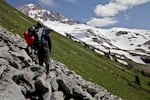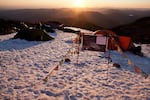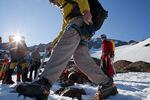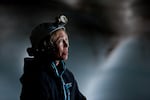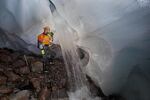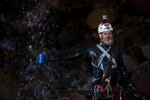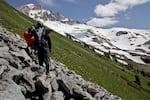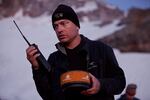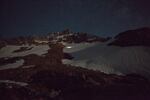
Eddy Cartaya ice climbing. During their week on the glacier, the team surveys the caves and searches for new passages.
Katie Campbell
Read Part I or visit the full digital version of THIN ICE.
Brent McGregor and Eddy Cartaya suspect that the spectacular caves they've discovered beneath a Mount Hood glacier won't survive for many more years.
Over the course of their adventures on Sandy Glacier, the explorers have watched as cave entrances they could once jump across melted out into chasms more than 60 feet wide.
The caves were melting out an astonishing rate - and shrinking the glacier in the process.
So they decided to organize a full-scale expedition to formally survey the caves and to begin tracking how much the inside of the glacier was melting. With the help of dozens of friends from Search and Rescue and the caving community, last summer they mapped and measured more than 7,000 feet of passages underneath the Sandy Glacier.
Experience THIN ICE
Check out OPB's full digital version of THIN ICE. opb.org/glaciercaves
Tune in Thursday, Oct. 10 at 8:30 p.m. to watch 'Glacier Caves: Mount Hood's Secret World' on OPB TV's Oregon Field Guide.
“I’m hoping it will make people appreciate the value of glacier resources, as they go away,” Cartaya says.
Planning an Expedition
More than anything, McGregor and Cartaya hope that scientists will take an interest in the caves. Last year, they reached out to Andrew Fountain, a glaciologist at Portland State University.
Fountain sent one of his graduate students, Gunnar Johnson, who studies the water chemistry of glaciers and microbes that live underneath the ice. Johnson said he found a surprisingly diverse population of tiny organisms that survive by essentially digesting the rock underneath the Sandy Glacier.
“If there is life on Mars to be found by this next rover, it’s going to look an awful lot like the things that are living under this glacier right now,” Johnson says.
Gunnar Johnson gathering data. Credit: Katie Campbell
But Fountain himself was lukewarm on the subject of glacier caves.
“There are some aspects of glacier caves that are interesting. As a main subject of study, not so much,” he said.
Fountain said he’d consider joining the expedition if he could find the time.
McGregor and Cartaya keep their fingers crossed while preparing for their second round of surveys.
When the expedition begins in late July, it takes the group most of a day to hike to the glacier terminus. They follow the Timberline Trail five miles to a steep climbers path, and then traverse a slope of heather and scree. Their packs are loaded with 80 pounds of gear: ropes, wetsuits, crampons and axes, freeze dried peas, survey gear, avalanche probes, oatmeal, cocoa, and a 45-pound RV battery.
McGregor and Cartaya give their little circle of tents at the glacier’s terminus an official name: Kamp Tenacious.
Camped out on the snow on the first night, Cartaya and McGregor’s team of volunteers can see the Milky Way and the lights of Portland 60 miles away.
The next morning, Gunnar Johnson, the doctoral student who’s been studying the microbial life in the caves, hikes in to take water samples. He brings good news: He’ll return to collect more samples tomorrow. And Andrew Fountain, the glaciologist, is planning to come with him.
The Snow Dragon
Buoyed by the news, McGregor and Cartaya begin their second year’s survey work in Snow Dragon cave. The most dangerous part of Snow Dragon is the entrance. Flakes of ice that weigh more than a ton threaten to pull away from the ceiling. Most members of the team do a little jog to pass through the entrance as quickly as possible.
The glacier is hundreds of years old. Bands of amber in the ice mark each year of snowfall that piled up on top the glacier and compressed into ice over time. In places, layers of perfectly clear ice show where winter rains pooled on the glacier or filled up crevasses and then re-froze when the temperature dropped.
Watch a slideshow:
http://www.flickr.com/photos/earthfixteam/sets/72157636158831555/show
Photography by Katie Campbell
The survey in Snow Dragon goes quickly at first. The cavers make their way from the entrance deep into the cave. It’s pitch black. Blocks of ice litter the floor. They stop every twenty feet or so to set up a survey point.
McGregor leans against a wall of ice, holding against it a measuring device that shoots a beam of red laser light to the cave’s opposite wall.
“A hundred-five,” he calls out. It’s hard for the men to hear each other over the roar of rushing water. The headwaters of the Muddy Fork River tumble past.
McGregor repeats each measurement three times for accuracy. Cartaya records the numbers in his yellow notebook and makes a quick sketch of the cave. In places, Snow Dragon is 10 feet wider than it was a year ago.
Page from Cartaya’s survey notebook.
The team finishes the easy part of the survey and prepares for a tricky climb.
McGregor and Cartaya have spotted a new pair of passages shaped like keyholes in the ice about 40 feet off the floor. They’re just large enough for a person to squeeze into. McGregor belays Cartaya up the curving wall of ice so he can see where they go.
“Call it. If you think it gets stupid, we’ll just stop,” Cartaya says.
Cartaya places ice screws as he climbs and clips his rope into them for safety. But the air temperature in Snow Dragon is above 40 degrees and the screws start to melt out almost as soon as Cartaya places them. The ice is brittle, so to avoid striking it with his axe he builds a ladder out of webbing as he climbs. An hour passes as Cartaya moves up the wall. The team watches, silent and anxious. Cartaya reaches a bulge of ice just below the passageway and sinks his axe in to pull himself up and over. Watch the video
“Big fracture when I did that….” Cartaya calls out to his friends watching from below.
If the fracture deepens, the bulge of ice could snap off with Cartaya on it. He carefully repositions his ax and pulls himself up and over. His yellow cave suit and then his boots disappear into the tube. He follows it until it dead-ends and adds another 40 feet to his map.
*A Dying Glacier *
The next day, members of the expedition watch as two small figures pick their way toward the glacier across the steep heather and the piles of scree.
Andrew Fountain has unruly hair and warm eyes and he’s wearing a bright Hawaiian shirt.
Cartaya kicks at the ice to form steps in the glacier and leads Fountain up for a look at the moulin. The scientist looks a little surprised.
“I’ve never seen anything quite like it,” he says.
He questions Cartaya about the survey work and how accurately it measures the height and width of each section of the cave. In Snow Dragon, he pulls out his camera and snaps a couple of pictures.
“Wow. Wow, wow, wow,” Fountain says, drinking in the huge empty space underneath the glacier. He tells McGregor and Cartaya he’s impressed with the changes they’ve observed.
“Your rates of enlargement over a short period of time are pretty big. It’s a small glacier, so this is a significant mass loss to these glaciers that are otherwise accounted for,” he says.
Andrew Fountain. Credit: Katie Campbell
Glaciologists like Fountain study mass balance – that is, how much ice glaciers gain or lose every year. Glacier mass balance tends to be a very sensitive indicator of long-term climate trends. Before learning of Cartaya and McGregor’s work, Fountain didn’t know of any effort to track how much the ice inside a glacier melts from year to year.
“We can make measurements from the surface by satellite, Lidar, surface measurements,” he says. “But nobody’s looked at what’s happening underneath the glacier.” Their surveys, he says, could provide insight into how these glaciers are decaying.
Cartaya and McGregor pepper Fountain with questions in turn. He tells them his gut sense is that the caves are a sign of a dying glacier. Fountain says the Sandy Glacier has retreated by at least 40 percent over the last 100 years. He hazards a guess that the ice used to be about 200 feet thicker.
“It’s the thinner ice caused by climate change that allows these caves to grow really big,” he says.
He predicts that within the next decade, the caves could open up into a deep slot canyon that divides the glacier in half. The best indication of what will happen to the Sandy, Fountain says, is the story of the Paradise Ice Caves.
It’s story McGregor and Cartaya know well.
Ice Caves in Paradise
For a while, something very close to the Sandy Glacier Caves existed on Mount Rainier, just two miles from the Paradise Lodge. The Paradise Ice Caves were the most popular attraction in Mount Rainier National Park for several decades.
Paradise Ice Caves. Circa. Early 20th Century.
Source: Mount Rainier National Park
In the 1950s, mountaineering legend Lou Whittaker took thousands of people to see the ice caves. He was fresh out of college at the time. A guided summit climb cost $28. The ice caves were just $5. Few people climbed Rainier back then.
“We’d rappel off the balcony on the lodge and land on the floor and say, let us tell you about the ice cave trips, and see if we could talk them into the five dollar fee,” Whittaker says.
Whittaker still vividly remembers the caves. “You could walk in 200 feet and still get this eerie green blue light which was awesome to see. And the cold air, even on a real hot day,” he says.
Watch: archival video from a late-1950s tour of Mount Rainier's Paradise Ice Caves.
Source: University of Washington Library. Credit: Bob and Ira Springs
Two factors determine whether a glacier advances or retreats: how much snow falls in the winter and how warm it is during the summer.
Most glaciers in the Northwest have been retreating since a little ice age in the 1800s came to an end, They’ve retreated more quickly as carbon has accumulated in the atmosphere and average temperatures here have risen.
The Paradise Glacier thinned so dramatically that a band of rock split the glacier in two, leaving the lower half starved of ice. The caves formed beneath the thinning ice. In 1940, the park’s naturalist wrote that the lower Paradise Glacier was stagnant and predicted it wouldn’t last long.
Paradise Glacier in 1936.
The same location in 2013.
But the 1950s and 1960s were good decades for snow at Rainer, and many of the glaciers there stopped retreating.
By the late 1970s, big holes opened in the ceiling of the caves, and they grew more dangerous. Within two decades, the lower half of the Paradise Glacier had melted.
The ice caves were gone.
“We live in a warming period. And times, they are a changing,” Whittaker says.
Paul Kennard, one of the park’s geologists, visited the Paradise Ice Caves in 1981, when very little of the glacier was left. At the time, he wasn’t alarmed.
“I think we saw the variations in the glaciers as just being a normal thing” he says. “We didn’t see this long-term trend.”
Now, Kennard says, he sees it as a reflection of global climate change. Every one of Rainier’s glaciers is at its historic minimum. Between 2003 and 2009, Rainer lost ice six times faster than it had in previous decades.
Changes
Back at Mount Hood’s Sandy Glacier, Fountain takes up his trekking poles for the hike down. He leaves Cartaya and McGregor with advice for improving their study: set up stakes and start measuring the surface snowmelt so they can see how that compares to the rate at which the caves grow.
Those rates have McGregor and Cartaya wondering how much longer the caves will be around. Of all the places they have surveyed, the moulin has changed the most dramatically.
Surveying the moulin was difficult to pull off, due to the rock fall danger and the freezing water that flows down the side of the pit during the day.
Glacier Caving Caution
When Brent McGregor and Eddy Cartaya explore the Sandy Glacier they follow safety protocols, including signing into cave register and staying in radio communication with local search and rescue teams.
Glacier cave exploration requires preparation for serious hazards:
Cartaya and McGregor waited until midnight, hoping the lower temperatures would minimize the risks.
Lit up by headlamps, the team headed up the steep slope, a little train of light moving up the dark flank of the mountain. McGregor dangled in the middle of the moulin like a spider on a line of silk, using his laser beam to measure the circumference in cross sections as he descended. Water streamed down the sides of the pit and drenched him as he worked.
A few weeks later, when Cartaya gets a chance to calculate the size of the moulin, he gets a sobering result: It’s about about four times larger than it was last year.
“In one way it’s exciting, because it means when we come back we’ll be able to document bigger and more frequent changes,“ Cartaya says.
On the other hand, he adds, “its kind of like losing a friend.”

